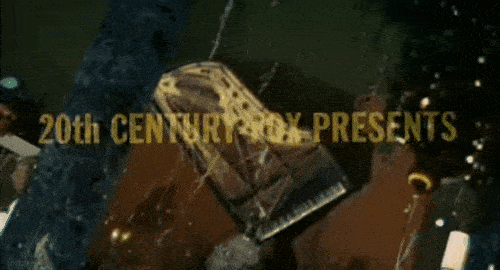Hey, fans of Netflix’s Lost In Space! You’re undoubtedly aware that the show is a remake of a classic 60’s scifi series, but do you know the long and storied history of the creator of that original show, the legendary Irwin Allen?
Yep, when the space family Robinson saga hit the airwaves in 1965, it was not the first of the televisuals brought to life by Allen, a filmmaker who got his start as a radio producer in the 1930’s, eventually moving on to producing and directing movies and documentaries. His heady foray into television in the 60’s was followed by arguably his biggest achievement, via two smash hit films in the 1970’s that cemented his reputation as the “Master of Disaster.” (More on that in a minute!) Let’s look at some of his other best known titles in today’s Friday Five!
Voyage to the Bottom of the Sea
The first of Allen’s TV sagas was a direct import of one of his earlier titles, a television adaptation of his 1961 film (and early disaster title) about a proto-futuristic submarine called the Seaview and her adventures in the deepest, uncharted regions of our oceans. The development of the TV series for a 1964 debut began relatively soon after the film’s release, which allowed for a tremendous amount of sets, costumes, props and FX models to be repurposed for the series. Voyage was a fun but pretty much straightforward adventure show, despite the future-set timeline – the final two seasons took place in the far-flung 1980s! – and the presence of co-star David Hedison, well known for genre titles including the original The Fly, Allen’s The Lost World and two appearances as Felix Leiter in the Bond films.
The Time Tunnel
Looking back, The Time Tunnel proved to be a forerunner for pretty much the entire time-travel genre on American TV, from Quantum Leap on down the list. It was not, however, the most successful of Allen’s television ventures, lasting just one season on ABC from the fall of 1966. It had a cool premise – an government time-travel experiment called Project Tic-Toc sets in motion the adventures of two scientists, one of whom goes through the machine in defiance of his superiors’ opinion that the project is worthless – plus Irwin’s pedigree and the presence of popular 60’s heartthrob James Darren as one of the leads. Though its influence would be felt later, its life was abrupt; the show was even cancelled so quickly that they never got the chance to film a planned episode where the heroes return to their timeline.
Land of the Giants
Debuting in 1968 as the last of Allen’s forays into sci-fi telly, Land of the Giants did manage to last two years despite, on the surface, bearing a striking plot similarity to Lost In Space: Accidental intergalactic stranding! In this one, set in the 1980s, a super-fast sub-orbital transporter gets hit by a freak magnetic storm, causing the craft to launch into an unexpected warp through the galaxy. It crash-lands on a planet where everything is twelve times larger than on Earth, including – dun, dun, dun! – the people! It’s a decent premise, though to be honest, Allen and company didn’t do much to craft a unique alien culture for their giant people; they bear an awful lot of similarities to Americans in the 1960’s, including their police, their hospitals, their broadcasting, their music and their recreation. One would hope that the five (!) novels that the series spawned despite its short shelf-life had more creativity at hand.
The Poseidon Adventure
It was inevitable that a visionary like Allen would eventually be lured back to the big screen, and it was in 1972 that he made arguably his greatest film and cemented his legacy in a particular sub-genre: The disaster movie. The Poseidon Adventure – about a luxury liner that capsizes on its way to Greece during a mother-of-all-storms – kick-started so many of the tropes that would come to define the disaster genre, including larger-than-life sets and action sequences and an all-star cast – any of whom, no matter how many Oscars they have or how big their paycheck is, could get bumped off at any moment. It’s the granddaddy of them all, with a superb ensemble (Shelly Winters! Roddy McDowall! Ernest Borgnine!) led by Gene Hackman as the most action-oriented priest you could ever want to meet in the middle of a disaster.
The Towering Inferno
Just two years later, Allen attempted to top Poseidon with this, his San Francisco-set disaster epic about a dazzling skyscraper which goes up in flames because someone decided to try and save a little money on cheap electrical wiring. It doesn’t quite hit the heights of suspense that its predecessor did, but all of Allen’s classic tropes are in play here, and it’s hard to deny that the dual star power of Paul Newman and Steve McQueen is pretty swoon-enducing. Again, absolutely no one is safe, not luminous Faye Dunaway, or smarmy Richard Chamberlain, or Bobby Brady (we see you, Mike Lookinland!) or even sweet, reluctant con man Fred Astaire. Oh, and OJ Simpson is there. And he rescues a cat from a burning apartment. Yeah, 1974 was a different time…
BONUS!
Lost in Space (the original!)
Yes, today’s list is about introducing you to the Irwin Allen ouevre outside of Lost In Space-related stuff. But I’d be remiss if I didn’t give you the opportunity to bop around to arguably one of the greatest title sequences of the 1960’s. The earlier version during the show’s black and white run was pretty good, but this banger when they transitioned to color, this was my jam when it aired in syndication during my childhood. Oh and, both were written by the one and only John Williams, of course! Please enjoy. (And don’t forget, the entire o.g. Lost In Space is available to stream, if you’re curious.)



